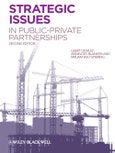As Public private partnership (PPP) arrangements become an increasingly popular way for national governments to fund and develop public infrastructure and urban areas with private sector contributions, a better understanding of the risks involved is crucial.
The second edition of Strategic Issues in Public Private Partnerships :
- Provides an international overview of the application of concessions - the most common form of PPP [eg PFI (Private Finance Initiative); BO(O)T (Build/Own/Operate/Transfer) or DBFMO (Design/Build/Finance/ Maintain/Operate)].
- Focusses on the introduction of concessions and the problems encountered, the solutions found for these problems, and the different approaches to concessions chosen across different countries.
- Provides a strategic overview for those involved in setting up and managing PPP projects.
- Illustrates lessons from different national backgrounds and gives managers the insight and tools to manage PPP projects effectively.
Essential reading for Contractors & funding organizations involved in PPP projects as well as Researchers in construction management and public administration.
Table of Contents
Glossary ixAcknowledgments xi
Introduction xiii
1 The Emergence of Concessions 1
1.1 The rise of public-private partnerships 3
1.1.1 New Public Management 5
1.1.2 The impact of NPM on the provision of public infrastructure 5
1.2 Different forms of public-private partnerships 7
1.2.1 The public-private spectrum 8
1.2.2 Typology and explanation 10
1.3 Concessions 10
1.3.1 History 12
1.3.2 Definitions 13
1.3.3 Motives 16
1.3.4 Explanation: Value for Money 19
1.4 Overview 21
2 Procurement of Concessions 23
2.1 Procurement strategies 24
2.1.1 Procurement types 25
2.2 The concession structure 28
2.2.1 Government role 29
2.2.2 Special Purpose Vehicle 29
2.2.3 Financing sources 31
2.3 Decision-making process 32
2.4 Tendering concessions 33
2.4.1 Market consultation or request for information (RFI) 34
2.4.2 Request for (pre)qualification (RFQ) 34
2.4.3 Invitation to tender or request for proposal (RFP) 35
2.4.4 Tender evaluation and short listing 36
2.4.5 Negotiation with short-listed tenders 36
2.4.6 Selection of the tender, award of concession, and financial close 36
2.5 Institutional procurement guidelines 37
2.5.1 European directives 37
2.5.2 Directives in the USA 40
2.5.3 The role of the institutional context in PPP developments 42
2.6 Contracts and cooperation 44
3 Infrastructure Concessions 49
3.1 Overview of developments 50
3.1.1 United Kingdom 50
3.1.2 Spain 52
3.1.3 Portugal 55
3.1.4 United States of America 58
3.1.5 Other global examples of PPP in economic infrastructure 60
3.2 International comparison 62
3.3 Lessons learnt 64
4 Social Infrastructure 65
4.1 Overview of development of concessions in health 67
4.1.1 United Kingdom 68
4.1.2 Reflections on social infrastructure concessions 72
4.1.3 Australia 72
4.2 Explanation of the similarities and differences between countries 77
4.3 Lessons learned and challenges 81
5 Concession PPPs and Flexibility 83
5.1 The incompleteness of contracts 84
5.2 Flexibility in hospital concessions 85
5.2.1 Changes in catchment’s population 86
5.2.2 Changes in medical technologies 86
5.2.3 Changes in policies 87
5.2.4 Design flexibility 87
5.2.5 Service flexibility 88
5.3 The way forward 93
6 Economic Context and Concessions 95
6.1 Financing of concessions 95
6.2 Project finance 96
6.2.1 Finance structure 96
6.2.2 Differences between financing economic and social infrastructure concessions 98
6.2.3 Refinancing 98
6.2.4 Banks versus bonds 99
6.3 The influence of the economic situation on concessions 100
6.3.1 Effects credit crisis on concession projects 101
6.3.2 Changes in concession processes 105
6.3.3 Strategies for changing economic situations 105
6.4 Looking forward 109
7 Concessions and the Public Interest 111
7.1 Introduction 111
7.2 Public interest and concessions 112
7.2.1 Safeguarding the public interest? 112
7.2.2 Concessions and the public interest 113
7.3 Institutional arrangements to safeguard the public interest 114
7.4 Project governance strategies and the public interest 117
8 Value for Money Revisited 121
8.1 Value for Money: an introduction 121
8.2 Ex-ante VFM assessment: the Public Sector Comparator 123
8.2.1 Calculating the PSC 124
8.2.2 Risks in assessing VFM by the PSC 125
8.3 Criticisms of VFM assessment using the PSC 128
8.3.1 The restricted measurement scope of the PSC 128
8.3.2 Imperfect assessment methods in PSC benchmarking 129
8.3.3 Propositions for ex-post VFM assessment methods 134
8.4 Concessions evaluated 136
8.4.1 Macro-economic effects 136
8.4.2 Political motives 138
8.4.3 State of the infrastructure 140
8.4.4 Side effects 141
8.5 Defining an improved VFM framework 141
8.5.1 VFM: focus on risks and uncertainties 142
8.5.2 VFM: an improved framework for monitoring and ex-post evaluation 145
9 Conclusion – PPPs and Future Developments 147
9.1 Concession arrangements in perspective 147
9.1.1 Concession PPPs: a worldwide concept 147
9.1.2 The debate on concession PPPs 149
9.2 Concession arrangements revisited 150
9.3 Towards a successful implementation of concession PPPs 153
9.3.1 Strategy should follow structures 153
9.3.2 Bundling and portfolio partnerships 154
9.3.3 Focus on relationship building 155
9.4 The future of concession PPPs 155
9.4.1 A new business model 156
9.4.2 Opportunities for extending the concession policy 157
9.5 Research and education on concessions 158
References 161
Index 177








